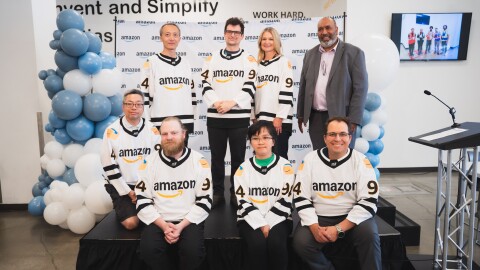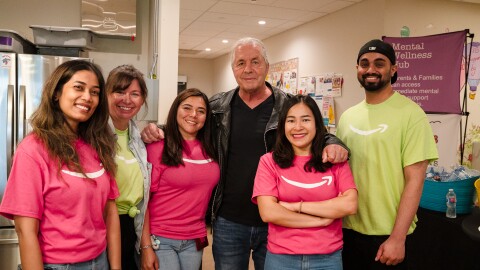At Amazon, we believe that creating a culture that is diverse, equitable, and inclusive is integral to people doing their best work, and is essential to what we can achieve as a company. Our culture of inclusion is reinforced within our 16 Leadership Principles, which remind team members to seek diverse perspectives, learn and be curious, and earn trust.
We believe that our ability to innovate on behalf of our customers relies on the perspectives and knowledge of people from all backgrounds. We actively recruit and develop people from diverse backgrounds to build a supportive and inclusive workplace, and we take steps to ensure employees have a sense of belonging, value, and opportunity.
Amazon recognizes that gender pay gap (GPG) reporting is just one element of a wider strategy to address gender equity. While GPG reporting alone cannot determine or resolve the complex set of causes for these differences, it is a crucial and welcome element. As we strive to be Earth's best employer, we take this initiative seriously.
What is the difference between gender pay gap and equal pay?
GPG compares the average pay of all working men and women, regardless of their job title, level, working patterns, organization levels, qualifications, or experience. GPG is an expression of the difference in the overall average earnings between all men and women within an organization. Equal pay, on the other hand, ensures that people receive equal pay for equal work, regardless of their gender. Therefore, the presence of a GPG does not mean that there is a difference in pay for men and women in the same roles. At Amazon we regularly perform equal pay audits and are committed to equal pay.
The British Columbia Pay Transparency Act requires all companies with 300 or more employees to publish a pay transparency report by November 1, 2025. The Amazon entities in Canada that fall into this category are Amazon Canada Fulfilment Services, Amazon Development Centre Canada and Amazon Web Services Canada. The mean gender pay gap for these entities ranges between 6.9% and -24.5%.
Amazon’s British Columbia gender pay gap reports are available here.
How is Amazon working to create a more diverse and equitable workforce?
To improve gender representation and achieve our goals, we run a wide range of initiatives to inspire, recruit, and develop women and non-binary people inside and outside of Amazon.
At Amazon, we acknowledge that there is still work to be done within our business and we are dedicated to creating a more diverse workforce where employees from all backgrounds can build new skills and grow their careers.
Career Choice is an education benefit that empowers frontline employees to learn new skills for career success. Amazon now pre-pays up to 100% of tuition and fees (up to a yearly maximum) towards a certificate or diploma in qualified fields of study, eliminating the 5% employee contribution requirement and removing the cost barrier to higher education in fields including truck driving, data analytics, and cybersecurity.
To date, more than 12,000 employees across Amazon’s Canadian fulfilment network have enrolled in Career Choice. Employees are now eligible to participate in the program after 90 days of employment.
Inspiring more girls and women to consider a career in tech from an early age Amazon supports a variety of programs that aim to help inspire more people from underrepresented communities to consider computer science and technology careers.
Amazon Future Engineer (AFE) is a comprehensive program designed to inspire, educate, and prepare children and young adults from underrepresented and underserved communities to pursue computer science. Since launching in Canada in 2021, the program has partnered with leading Canadian charities dedicated to computer science education to fund preparatory lessons, tutorials, online resources and workshops designed to inspire students from all backgrounds, from Kindergarten through high school, to give computer science a try. AWS supports a number of initiatives that encourage women and girls to pursue studies and careers in technology:
In an effort to bring more women into the tech workforce, AWS re/Start, a free-to-the-learner, cohort-based workforce development program that helps unemployed and underemployed individuals build cloud computing skills and launch a career in the cloud, teamed up with Momentum to launch a Tech Training for Women Program.
Through the AWS InCommunities program, AWS works to make a positive impact in the communities where its data centres are located and where its employees live, work and raise their families. In September 2024, we opened the first AWS Think Big Space in Canada, at Centre Lasallien in Montreal, Quebec, where visitors can explore a range of learning paths, including coding, programming, and robotics. The program includes activities that introduce young women to artificial intelligence (AI) and scientific experimentation, ensuring that the future talent are quickly exposed to technologies they could one day work with.
Retraining and upskilling for technology careers
AWS continues to invest to empower developers, students, and the next generation of IT leaders in Canada to upskill, reskill, and prepare for high-quality jobs. From ready-to-teach high school and college courses, to full-time skills development programs and self-paced learning content, our programs provide individuals from all backgrounds and experience levels the opportunity to develop cloud skills and become lifelong AWS learners. For example, AWS Skill Builder is an online learning centre providing learners of various skill levels, roles, and backgrounds with access to more than 600+ free online courses in up to 14 languages to build knowledge and practical skills. Additionally, learners can utilize AWS Skill Builder’s flexible learning plans to help build in-demand cloud skills for a specific domain.
Creating an inclusive culture
To cultivate a community of inclusion amongst our employees, we recognize that we must not only recruit a diverse pool of talent, but also ensure we are nurturing and developing the employees already at Amazon. We are committed to creating a diverse organization where employees thrive.
For example, Amazon helps employees with the transition back to work after parental leave. Following all local and statutory requirements, Amazon offers up to 14 weeks of paid pregnancy leave for birthing parents. Birthing parents and non-birth parents welcoming a baby or adopting a child are eligible for six weeks of Paid Parental Leave. This leave also includes our Leave Share program, allowing employees to give six weeks of paid parental leave to a spouse or partner who isn’t eligible for parental leave from their employer. Plus, our Ramp Back program offers parents eight consecutive weeks of flexibility and partial work hours as they readjust to work schedules as new parents.
Amazon has many employee-led groups, which help employees come together across businesses and locations around the world. These are employee-run volunteer groups, designed to offer connection and support, while enhancing employee engagement, inclusion and social responsibility. Women@Amazon and Amazon Women in Engineering (AWE) are examples of groups that are active in BC and have chapters dedicated to attracting, developing and retaining women in operations and technology roles. Other groups include People with Disabilities, Mental Health and Wellbeing, Black Employee Network, Asians@Amazon, and Glamazon (our LGBTQIA+ network). Find out more about our Amazon employee-led groups here.
We continue to invest in local inclusion programs, and there are also dedicated Inclusive Experiences and Technology teams that support leaders and employees across Amazon in Canada to drive progress. We believe this is important work, and we will keep investing in programs that help us reflect the customers we serve and help employees grow, thrive, and connect.Find out more about inclusion and diversity at Amazon.












